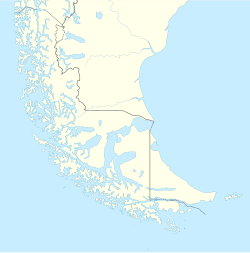烏蘇懷亞
烏蘇懷亞(西班牙語:Ushuaia,西班牙語發音:[uˈswaja])是阿根廷火地省的首府,位於大火地島南岸,座落在群山環抱之中,遠眺比格爾海峽,被認為是世界最南端的城市(而非更小的城鎮。雖然有人認為智利威廉斯港在地理上更靠近南極,但大部份人認同以發展規模來看該地只能算小鎮)。2010年普查人口為56,956人[1]。
| 烏蘇懷亞 Ushuaia | |
|---|---|
| 城市 | |
 | |
| 座標:54°48′7″S 68°18′11″W / 54.80194°S 68.30306°W | |
| 國家 | |
| 省 | |
| 海拔 | 5 公尺(16 英尺) |
| 人口(2010年普查[1]) | |
| • 總計 | 56,956人 |

市中心由一條以阿根廷國父聖馬丁(Avenida San Martín)為名的石板路所貫穿,街道兩旁有很多專做觀光客生意的禮品店、百貨店、餐廳和販賣當地加工區生產的免稅電器商品店。城內的烏蘇懷亞博物館是由廢置的監獄改裝而成,兩層樓的建築物本身就是歷史的遺跡,館內分成監獄和海事兩個展示部,監獄館依然保存昔日監獄的原貌和設施,展出烏蘇懷亞早期的照片和一些重要囚犯的資料。
市名最早由英國探險家根據當地原住民地名發音所起。在20世紀前半部分時間裡,這裡一直是重刑犯的流放地。阿根廷政府在這裡建立監獄就是效仿英國在澳大利亞的做法,這是一個偏僻的島嶼,從這裡逃脫是不可能的。囚犯在這裡花費大量時間伐木並建造了這座城市。
烏蘇懷亞還是通往南方地區的要塞,有來自布宜諾斯艾利斯的定期班機(停靠在烏蘇懷亞國際機場),而該城還有設備完善的港口,其距南極大陸最近處僅800公里,所以是阿根廷和其他國家去南極考察的後方基地,考察船都在這裡補充燃料和食品。此外還有班輪通航阿根廷首都、智利火地島首府蓬塔阿雷納斯和福克蘭群島(即馬爾維納斯群島)。
氣候
編輯烏蘇懷亞的氣候類型屬於亞極地海洋性氣候,氣溫隨月份變化的幅度非常小,最熱月份的平均溫度約10°C,最冷月份的平均溫度則高於0°C,亦出現過-21°C的極端低溫。
雖然年降水量僅500mm~600mm,但該城市一年中有200日以上的陰雨天氣,因此非常陰涼潮濕。
降雪在烏蘇懷亞很常見,每年都發生。
相比同氣候類型下常見的苔原景觀,烏蘇懷亞有較茂密的森林。
| 烏蘇懷亞機場 (1981–2010正常值,1901年至今極端數據)[a] | |||||||||||||
|---|---|---|---|---|---|---|---|---|---|---|---|---|---|
| 月份 | 1月 | 2月 | 3月 | 4月 | 5月 | 6月 | 7月 | 8月 | 9月 | 10月 | 11月 | 12月 | 全年 |
| 歷史最高溫 °C(°F) | 29.5 (85.1) |
28.9 (84.0) |
25.6 (78.1) |
22.2 (72.0) |
20.3 (68.5) |
19.0 (66.2) |
17.5 (63.5) |
18.0 (64.4) |
22.3 (72.1) |
21.2 (70.2) |
26.3 (79.3) |
29.0 (84.2) |
29.5 (85.1) |
| 平均高溫 °C(°F) | 14.5 (58.1) |
14.1 (57.4) |
12.1 (53.8) |
9.8 (49.6) |
6.9 (44.4) |
4.2 (39.6) |
4.6 (40.3) |
6.1 (43.0) |
8.1 (46.6) |
10.5 (50.9) |
12.2 (54.0) |
13.3 (55.9) |
9.7 (49.5) |
| 日均氣溫 °C(°F) | 9.7 (49.5) |
9.5 (49.1) |
8.0 (46.4) |
6.0 (42.8) |
3.8 (38.8) |
1.7 (35.1) |
2.4 (36.3) |
2.9 (37.2) |
4.2 (39.6) |
6.3 (43.3) |
7.7 (45.9) |
8.8 (47.8) |
5.9 (42.6) |
| 平均低溫 °C(°F) | 5.6 (42.1) |
5.6 (42.1) |
4.3 (39.7) |
2.9 (37.2) |
1.1 (34.0) |
−1.2 (29.8) |
−1.1 (30.0) |
−0.3 (31.5) |
0.6 (33.1) |
2.3 (36.1) |
3.6 (38.5) |
4.6 (40.3) |
2.3 (36.1) |
| 歷史最低溫 °C(°F) | −2.0 (28.4) |
−4.0 (24.8) |
−4.3 (24.3) |
−7.3 (18.9) |
−20.2 (−4.4) |
−18.2 (−0.8) |
−21.0 (−5.8) |
−19.6 (−3.3) |
−10.6 (12.9) |
−6.1 (21.0) |
−6.0 (21.2) |
−3.7 (25.3) |
−21.0 (−5.8) |
| 平均降水量 mm(英寸) | 49.5 (1.95) |
42.1 (1.66) |
46.8 (1.84) |
55.9 (2.20) |
47.6 (1.87) |
56.4 (2.22) |
40.1 (1.58) |
36.0 (1.42) |
34.5 (1.36) |
36.1 (1.42) |
41.3 (1.63) |
50.7 (2.00) |
537.0 (21.14) |
| 平均降水天數(≥ 0.1 mm) | 17.1 | 14.2 | 14.9 | 15.8 | 14.0 | 14.2 | 15.3 | 14.4 | 13.3 | 14.4 | 16.0 | 16.8 | 180.4 |
| 平均降雪天數 | 0.3 | 0.1 | 2 | 2 | 5 | 8 | 7 | 9 | 7 | 5 | 3 | 1 | 49.4 |
| 平均相對濕度(%) | 75 | 76 | 78 | 80 | 81 | 82 | 82 | 80 | 76 | 73 | 72 | 74 | 77 |
| 月均日照時數 | 167.4 | 146.9 | 133.3 | 102.0 | 68.2 | 42.0 | 55.8 | 83.7 | 123.0 | 164.3 | 180.0 | 167.4 | 1,434 |
| 可照百分比 | 32.0 | 34.5 | 33.5 | 31.5 | 25.7 | 18.5 | 22.5 | 27.5 | 34.0 | 37.5 | 37.0 | 28.5 | 30.2 |
| 資料來源1:NOAA (humidity 1961–1990),[2] 世界氣象組織 (average high and low, and precipitation),[3] Secretaria de Mineria (extremes and sun, 1901–1990)[4] | |||||||||||||
| 資料來源2:Servicio Meteorológico Nacional (extremes),[5] UNLP (snowfall data),[6] Tokyo Climate Center (mean temperatures 1981–2010)[7] | |||||||||||||
圖集
編輯參見
編輯註釋
編輯- ^ The record highs and lows are based on the Secretaria de Mineria link for the period 1901–1990 while records beyond 1990 come from the Servicio Meteorológico Nacional link since it only covers from 1961–present. When these 2 sources are used together, the record highs and lows are from the period 1901–present
參考來源
編輯- ^ 1.0 1.1 INDEC (Argentine Ministry of Economics) 2010 Census results (PDF). [2011-11-21]. (原始內容 (PDF)存檔於2012-04-25).
- ^ Ushuaia AERO I Climate Normals 1961–1990. 美國國家海洋和大氣管理局. [2015-10-20]. (原始內容存檔於2020-08-21).
- ^ World Weather Information Service – Ushuaia. World Meteorological Organization. [23 March 2017]. (原始內容存檔於23 March 2017).
- ^ Provincia de Tierra del Fuego – Clima Y Meteorologia: Datos Meteorologicos Y Pluviometicos. Secretaria de Mineria de la Nacion (Argentina). [7 April 2013]. (原始內容存檔於19 January 2015) (西班牙語).
- ^ Clima en la Argentina: Guia Climática por localidades. Caracterización: Estadísticas de largo plazo. Servicio Meteorológico Nacional. [28 January 2018]. (原始內容存檔於2019-02-07) (西班牙語).
- ^ Datos bioclimáticos de 173 localidades argentinas. Atlas Bioclimáticos. Universidad Nacional de La Plata. [5 April 2014]. (原始內容存檔於2019-08-25) (西班牙語).
- ^ Normals Data: USHUAIA AERO - ARGENTINA Latitude: 54.80°S Longitude: 68.32°W Height: 28 (m). Japan Meteorological Agency. [13 January 2019]. (原始內容存檔於13 January 2019).
